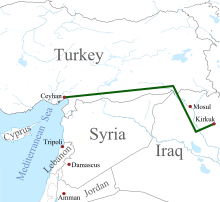Kirkuk–Ceyhan Oil Pipeline
| Kirkuk–Ceyhan Oil Pipeline | |
|---|---|
 Location of Kirkuk–Ceyhan Oil Pipeline | |
| Location | |
| Country | Iraq, Turkey |
| General direction | east-west |
| From | Kirkuk, Iraq |
| To | Ceyhan, Turkey |
| General information | |
| Type | oil |
| Commissioned | 1970 |
| Technical information | |
| Length | 600 mi (970 km) |
| Maximum discharge | 1.6 million barrels per day (250×103 m3/d) |
The Kirkuk–Ceyhan Oil Pipeline, also known as the Iraq–Turkey Crude Oil Pipeline, is a 600-mile-long (970 km) pipeline that runs from Kirkuk in Iraq to Ceyhan in Turkey. It is Iraq's largest crude oil export line.
Technical description[edit]
The pipeline consists of two pipes with diameters of 46 inches (1,170 mm) and 40 inches (1,020 mm) and designed capacity of 1,100 thousand and 500 thousand barrels per day (~5.5×107 and ~2.5×107 t/a) respectively. Usable capacity of the line is believed to be only 300 thousand barrels per day (~1.5×107 t/a), with significant repairs still required.[1]
Incidents of sabotage[edit]
The line's Iraqi part has been a principal sabotage target since 2003.[2] On 26 October 2009, the blast near Mosul halted oil supplies through the pipeline.[3] On 16 August 2013, at around 0100 GMT near the al-Shura area 60 km to the south of the city of Mosul a bomb attack damaged the pipeline.[4] On 3 September 2013, at around 0200 GMT near Ein al-Jahash area, a bomb attack damaged the pipeline.[5]
Pipeline[edit]
In 2013, the Kurdistan Regional Government of Iraq completed a pipeline from the Taq Taq oil field through Khurmala (the northwest sector dome of the greater Kirkuk field) and Dahuk to Pesh Khabur (Fesh Khabur) on the Turkey-Iraq border, where it is connected to the Kirkuk-Ceyhan pipeline. This 36-inch (910 mm) diameter pipeline has capacity of 150,000 barrels per day (24,000 m3/d). It allows the export of oil from the Taq Taq and Tawke oil fields.[6] On 23 May 2014, the Kurdistan Regional Government announced that the first oil transported via the new pipeline was loaded into a tanker at Ceyhan.[7]
New pipeline proposal[edit]
Iraq is considering building a new Kirkuk–Ceyhan pipeline to bypass attack-prone areas and double the export capacity.[8]
See also[edit]
References[edit]
- ^ "Gulf states mull over Hormuz bypass". Upstream Online. NHST Media Group. 2007-05-11. Retrieved 2008-03-08.
- ^ "Explosion at fuel pipeline west of Baghdad". USA Today. 2003-06-22. Retrieved 2008-03-08.
- ^ "Blast rocks Kirkuk export link". Upstream Online. NHST Media Group. 2009-10-28. Retrieved 2009-10-28.
- ^ "Iraq-Turkey oil pipeline bombed: officials". Reuters. 2013-08-16.
- ^ "Bomb attack halts Kirkuk-Ceyhan pipeline crude flow". The Peninsula Qatar (newspaper). Dar Al-Sharq. 2013-09-03. Archived from the original on 2013-09-03. Retrieved 2013-09-03.
- ^ "Operations in Kurdistan Region of Iraq". Genel Energy. Archived from the original on 2014-06-12. Retrieved 2014-06-14.
- ^ "KRG statement on first oil sales through pipeline export" (Press release). Kurdistan Regional Government. 2014-05-23. Archived from the original on 2014-07-15. Retrieved 2014-06-14.
- ^ Coskun, Orhan (2014-04-09). "Iraq wants to raise Kirkuk-Ceyhan oil flow above 1 mln bpd-minister". Reuters. Retrieved 2014-06-16.
